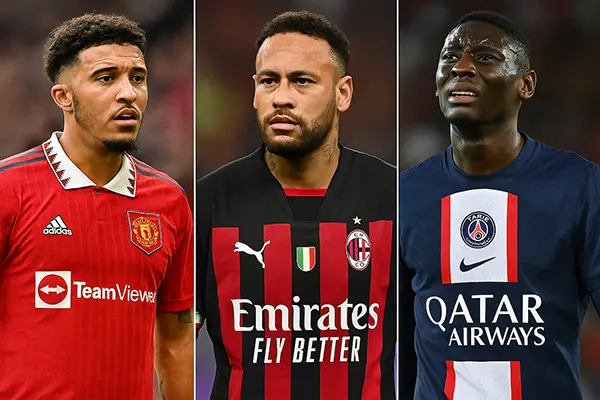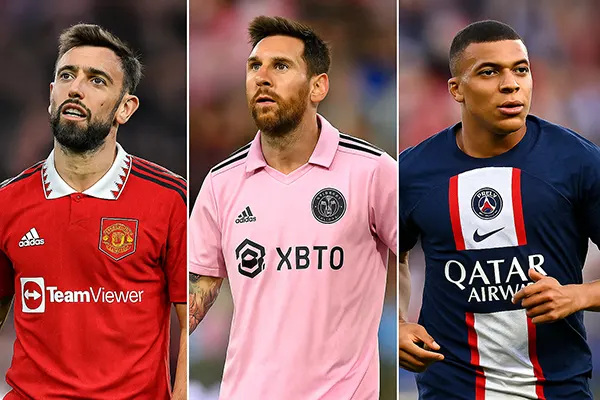5 Most Absurd Football Transfers of 2024/2025: When Money Fails to Deliver

The football transfer market never ceases to surprise, but the 2024/2025 season has delivered some truly baffling moves. With inflated price tags and lofty expectations, these five transfers stood out not for success, but for their miscalculations. This article delves into the most disappointing and irrational transfers of the year, examining why even astronomical sums fail to guarantee results.
Jadon Sancho’s Short-Lived Reunion with Manchester United
After an underwhelming stint in Germany post-loan, Manchester United shocked fans and pundits alike by re-signing Jadon Sancho for €50 million. The hope was to rekindle his early promise, but the outcome was a rehash of his past frustrations. Struggles with form, inconsistency on the pitch, and a reported clash with coaching staff quickly brought his return into question.
Sancho’s transfer, pushed by a managerial change and a desperate need for creativity, turned sour within months. Despite a strong pre-season, his Premier League performances lacked dynamism and urgency. Fans were left wondering whether the club had truly assessed his suitability for Erik ten Hag’s evolving tactics.
As the season progressed, Sancho found himself benched more often than not. United’s financial gamble, especially in a year where Financial Fair Play scrutiny was high, left them with minimal returns both on the pitch and commercially. This misstep underlines the club’s ongoing transfer woes.
Reputation Over Rationality: A Recurring United Theme
Manchester United’s obsession with marquee names continues to cloud their strategic vision. Sancho’s re-signing appeared driven more by branding than fit. Club officials hoped to spark fan excitement, but the decision ignored tactical harmony and squad balance.
Media hype further amplified the unrealistic expectations placed on the winger. Sancho, still battling confidence issues and fitness concerns, was thrust into the spotlight before he could fully recover or adjust. As a result, his contributions remained minimal throughout the 2024/2025 campaign.
Ultimately, the failed reunion highlighted a broader issue: the disconnect between United’s transfer committee and the club’s tactical needs. The Sancho saga will likely be remembered as one of the most ill-advised decisions of the season.
Neymar’s Saudi Adventure Ends in Silence
Neymar’s move to Al-Hilal in 2023 was already controversial, but his unexpected transfer back to Europe in 2024—joining AC Milan for €35 million—left fans speechless. The Brazilian’s return was hailed as a masterstroke by Milan’s management. However, reality painted a different picture.
After just three appearances, Neymar suffered a re-aggravated knee injury. Medical evaluations later suggested that the club had overlooked key health indicators during negotiations. His contribution to the team’s Champions League campaign was effectively nil, and his absence strained Milan’s attacking depth.
The financial implications were severe. Milan’s reliance on ticket and merchandising revenue tied to Neymar’s star power fell short of projections. Critics accused the club of chasing spectacle over substance, particularly when rebuilding efforts required dependable, long-term assets.
Risky Business in the Ageing Star Market
Clubs continue to fall for the allure of global stars, even when evidence suggests diminishing returns. Neymar’s recurring injuries and lifestyle choices should have been red flags for Milan’s decision-makers. Yet, blinded by his brand value, they moved forward hastily.
This misstep mirrors a trend seen across Europe, where clubs invest heavily in ageing icons to boost short-term revenues. However, few of these gambles yield sustained success, and Neymar’s case has become a cautionary tale about poor due diligence.
Milan now faces a harsh recalibration, stuck with a high-wage player whose fitness and future are in serious doubt. The Neymar transfer is a textbook example of prioritising marketing over meaningful squad development.

Randal Kolo Muani’s Parisian Nightmare
Randal Kolo Muani’s €90 million move to PSG was one of the most expensive transfers in Ligue 1 history. Expectations were sky-high after a standout Bundesliga season. Yet, within months, fans and critics began to question whether the club had misjudged his capabilities.
Kolo Muani struggled to integrate into Luis Enrique’s system. His lack of cohesion with Mbappé and Dembélé disrupted PSG’s fluidity, leading to dropped points in key matches. Moreover, his goal tally—just five in all competitions by February 2025—fell far below projections.
With PSG already under the microscope for past extravagant spending, this failed signing revived debates around the club’s transfer philosophy. Critics argued that the club pursued Kolo Muani without a clear understanding of how he would complement their attacking style.
The Cost of Poor Tactical Fit
One of PSG’s greatest weaknesses has been their scattergun approach to recruitment. Kolo Muani’s struggles stem from a misalignment between his style and the tactical environment he entered. His success in Frankfurt stemmed from counter-attacking football—something PSG rarely plays.
Rather than adapt to his strengths, the club shoehorned him into roles ill-suited to his skill set. This resulted in a visible drop in confidence and form. Despite his potential, the club’s handling of his development may have already inflicted lasting damage.
Going forward, PSG’s management must refine their scouting and analytical frameworks. A high price tag doesn’t automatically translate into success, and Kolo Muani’s season exemplifies how poor planning can undermine talent.
